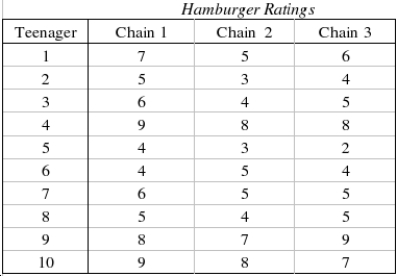The restaurant critic on a newspaper claims that the hamburgers that one gets at the hamburger chain restaurants are all equally bad and that people who claim to like one hamburger over others are victims of advertising. In fact, he claims that if there were no differences in appearance, then all hamburgers would be rated equally. To test the critic's assertion, ten teenagers are asked to taste hamburgers from three different fast-food chains. Each hamburger is dressed in the same way (mustard, relish, tomato, and pickle) with the same type of bun. The teenagers taste each hamburger and rate it on a 9-point scale with 1 = bad and 9 = excellent. The data are listed below.  Which statistical technique is appropriate if you want to compare the quality of hamburger of the three chain restaurants?
Which statistical technique is appropriate if you want to compare the quality of hamburger of the three chain restaurants?
______________
Can we infer at the 1% significance level that the critic is wrong?
Test Statistic: ______________
Reject Region:
Reject  if the test statistic > ______________
if the test statistic > ______________
Conclude: ______________
We ______________ infer at the 1% significance level that the critic is wrong.
Using the appropriate statistical table, what statement can be made about the p-value for this test?
______________
Definitions:
Family
A social unit typically bound by kinship, affinity, or co-residence, that forms the primary arena for socialization and support.
Assessment Center Process
A method used by organizations to evaluate candidates' abilities through a series of exercises and simulations, typically for hiring or promotion decisions.
Accurate
The degree to which information, measurement, or representation is exact and free from error.
Developmental Purposes
Objectives or goals aimed at growth, improvement, or progress, especially in personal, professional, or organizational contexts.
Q9: The Partnership for Sustainable Communities, an interagency
Q10: Discuss how elite theory is applied to
Q15: In the 1980s, the federal government sponsored
Q17: Why might forecasting be used to examine
Q38: The problem of multicollinearity arises when:<br>A) the
Q63: Plots of the residuals against <img src="https://d2lvgg3v3hfg70.cloudfront.net/TB8220/.jpg"
Q63: In regression analysis, a graph of each
Q68: In a goodness-of-fit test, suppose that the
Q137: Use the Wilcoxon rank sum test on
Q177: Let <img src="https://d2lvgg3v3hfg70.cloudfront.net/TB8220/.jpg" alt="Let be